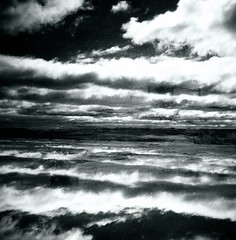There is a strong argument to be made that technology has placed more of the power of photography in the hand of ordinary people in more numbers than ever before. With digital point and shoot, especially the DLSR's and the ever multplying swarms of web cams and cell phone camera, you would be right to think that there are more options than ever when it comes to snapping a photo - at any time and in any place.
We are all able to race around posting photos to our Myspace's and Facebook's, to out Picasa's and Flickr's, digitally dragging and dropping our lives out onto the internet, have we really changed the way people take photographs?
Quite a lot of people would argue yes, I would suspect. In fact most of the serious amateurs and professional photographers that I encounter shoot with expensive DSLR cameras with loads of money invested into lenses computers, software etc. The bar for entry is rather high when it comes to costs, but once in a large DLSR allows you to shoot anywhere, anytime with as many images as you can shoot. Imagine you have a maching gun that allows you to shoot everything and with any luck you will hit your target. That is the essential philosphy for most DLSR photographers today, shoot, shoot and shoot. Couple this with technology and you are able to generate an enormous volume of images and communicate them with a large audinence via the internet.
Now to be clear, I am not arguing against "machine gun" photography, for photojournalism and documentary photography it is essential. What I would like to talk about is a simple, exacting approach to photography. The greats, Steiglitz, Adams and Weston all used medium and large format film cameras that seem archaic today. While the technology has sped forward in recent years, the need for an exacting philosophy has not. The key to all great art is "visualization". As a photographer, a painter, an engineer, or almost any other creative endeavor the ability to pre-visualize the photograph is essential. To paraphrase Ansel Adams, the goal is to bridge the gap between the desired image, and the skills you have to make it. With a few slective shots, take what is in the mind's eye of the photographer and make that image exist in the world.
This approach is rather different from that of shooting and shooting, in hopes that the camera will capture the image for you. So what does all this have to do with Lo-Fi and Sci-Fi. Well, hold on casue I was just about to get to that. If we compare say the Sony Alpha 900 DSLR with is 20+ megapixels and interchangable lenses, lighting and image quality, versus the Holga 120N Plastic camera with a fixed shutter and a near static 60mm lens, that shoots through a cheap piece of plastic onto a medium format film that you won't see until you develop the negative, we see that these are two distict tools used for achiving the same goal. That goal is to bring what you see in the world into reality for others. One is a sleek, powerful and futuristic instrument, the other is a weak and awkward.
Both tools achieve the goal, and in a world where everything is at our fingertips, on demand at the push of a button it can be liberating to lose control just for a little while. While at the same time controlling the direction we take artistically. It seems that these days many of us become so caught up in the megapixels and the color noise and myriad other thousands of ways to screw up a photo that we forget that it is okay to screw up on purpose, to let the mistake be part of the final image, to let coincidence play a role in the life of our photos.

No comments:
Post a Comment